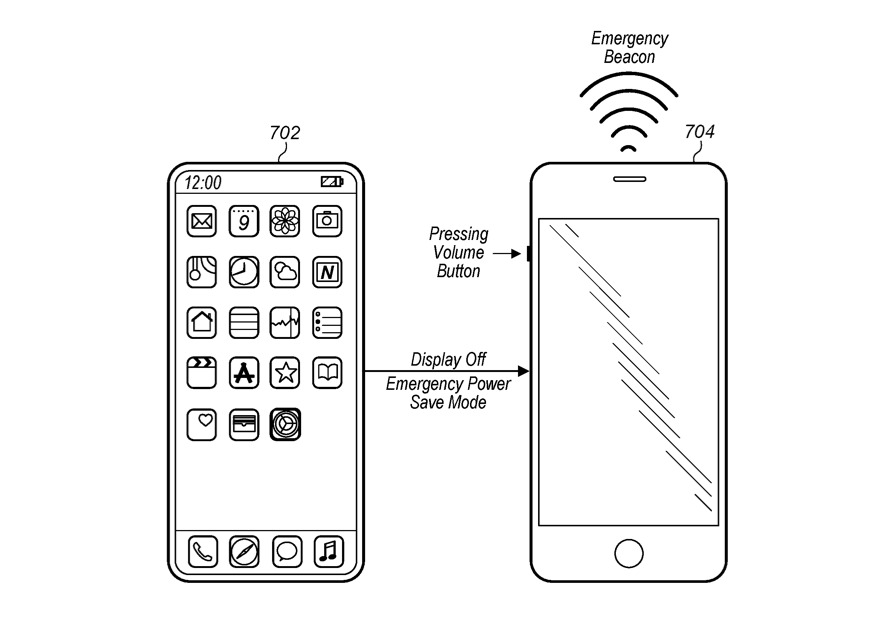A new patent describes multiple ways in which an iPhone could use cell signals, wi-fi or even other nearby devices to get an emergency distress beacon out, plus ways of prolonging the battery until rescue arrives.
Existing iPhones are able to alert the authorities on command, but Apple is planning new ways to help users in areas where regular cellphone coverage is either unavailable or problematic. A new Emergency Power Save Mode (EPSM) will be able to broadcast a distress signal in multiple different ways while also minimizing battery use in order to keep the device working until the user is rescued.
"Mobile electronic devices may take the form of smart phones or tablets that a user typically carries," begins Apple in US Patent No 20200015169, "Enhanced Emergency Beacon Sending Procedure".
"These and other devices may be carried by users in remote locations and a user may desire to broadcast an emergency beacon in a location that is not covered by cellular service," it continues.
Apple intends its procedures to become as much of a universal standard as possible, to the extent that the patent describes it being implemented on devices from PlayStation Portable to smart glasses and Android phones. Apple refers to all of these devices as User Equipment (UE).
"[The] UE may be configured to broadcast an emergency beacon in response to user input," says the patent. "For example, a user may become lost or injured while hiking and may use an emergency beacon broadcast feature to notify other users or base stations in the area... and as described in greater detail below, the emergency beacon broadcast feature may operate as an off-grid radio service (OGRS) when the UE does not have an active connection to a base station or other wireless access point."
There are broadly two elements to the procedure in the patent, starting with power saving.
"If a user of a UE is in a dire situation or another situation that would benefit from emergency beacon broadcasting or beacon broadcasting in general, a significant amount of time may pass before a broadcast emergency beacon is successfully received by another user or a base station and help is mobilized to assist the user," it says.
"For example, a user in a remote rural location may not be within a communicatively effective distance from other UEs or base stations capable of receiving the emergency beacon. As such, it may be desirable for the UE to be able to broadcast emergency beacons over an extended period of time, to increase the likelihood of a successful reception of the broadcast," it continues.
 Detail from the patent showing that the screen is the first thing to be switched off in order to save power in emergencies
Detail from the patent showing that the screen is the first thing to be switched off in order to save power in emergenciesSince such a user is unlikely to have access to power to recharge the battery, Apple says the power level "may potentially reduce the chance that the emergency beacon is successfully broadcast and received before the battery is drained."
Under Apple's proposed system, a user could elect to manually turn on the Emergency Power Save Mode. Or could choose beforehand to have it be automatically turned on when the battery falls below a specified amount.
In either case, once enabled, the EPSM would switch off the display, one of the biggest drains on battery life. The patent details the different power demands of the display, backlighting and "various other processes... over Wi-Fi and... GPS."
"[EPSM will] preserve battery while enabling emergency beacon broadcasting through efficient handling of the display of the device and radio frequency (RF) signaling."
The second part of the procedure involves how the emergency signal is broadcast. That includes attempting to locate and use a nearby cell service or local wi-fi network.
"[Alternatively,] emergency beacon may be an off-grid radio service (OGRS) device-to-device (D2D) communication. For example, the UE may broadcast an emergency beacon according to existing D2D communication protocols," says the patent. "The emergency beacon may be receivable by other UEs and/or by base stations."
The patent is credited to eight inventors, many of whom such as Lydi Smaini, Tarik Tabet and Mohit Narang, have prior filings for Apple surrounding inventions concerning signal transmission, and power consumption.
 William Gallagher
William Gallagher






-m.jpg)






 Marko Zivkovic
Marko Zivkovic
 Mike Wuerthele
Mike Wuerthele
 Christine McKee
Christine McKee
 Amber Neely
Amber Neely
 Sponsored Content
Sponsored Content
 Wesley Hilliard
Wesley Hilliard











11 Comments
Great idea. Hopefully the Watch could do this too at some point.
Wifi I have disabled, until I manually turn it on. Will EPSM turn it on without my input?
Wifi burns though battery life like nobody’s business (searching) when the signal is weak or non existent... sounds like a problem if the goal is to extend battery (emergency signal life).
Boosting the (emergency) signal beyond what is normally legally allowed, seems more useful... then repeat the EPSM transmission periodically.
I really hope it can broadcast to something, somewhere where I hunt. There is no cell service with lots of valleys and canyons. About the only way the signal would be seen is if it has some sort of satellite connection. Maybe these new mini sats Amazon, SpaceX and and others are sending up would be the hookup?